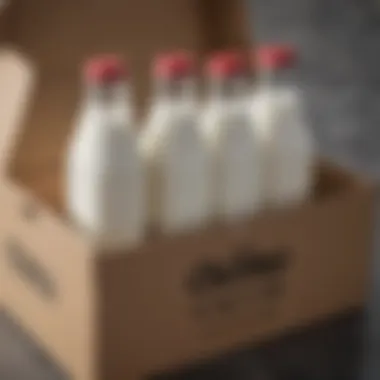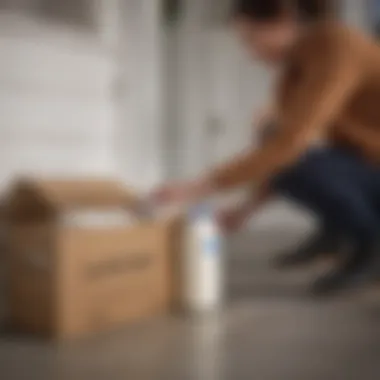Discover the Benefits of Milk Delivery Boxes for Your Porch


Intro
In today’s fast-paced world, consumers seek convenience without sacrificing quality. One solution that stands out is the integration of milk delivery boxes into modern homes. Thene modest yet highly practical boxes offer a level of freshness and accessibility that traditional grocery shopping often lacks. As the trend for personalized food delivery continues to rise, understanding the certain benefits of these systems becomes important for anyone looking to adjust lifestyle habits.
Essentially, milk delivery boxes are designed to keep your dairy products cold and protected while you go about your busy day. They can fit conveniently on your porch or doorstep. Not needing to think about refrigeration during those busy mornings can result in significant time savings.
However, let’s discuss why these boxes matter now more than ever. These systems can also combat food waste and contribute towards maintaining product quality for longer periods. As people increasingly prioritize sustainability alongside convenience, milk delivery boxes offer an effective way to bridge that gap.
Benefits of Milk Delivery Boxes
- Consistency: Regular delivery schedules ensure that you have fresh milk available when you need it.
- High Quality: The specific design of these delivery systems helps in preserving the freshness of milk and other dairy products.
- Reduced Waste: Minimizing trips to the grocery store not only decreases packaging waste but also supports a more sustainable food model.
This article will explore various facets of milk delivery boxes, including their types, advantages, and essential maintenance to guarantee sustained use.
Intro to Milk Delivery Services
Milk delivery services have regained prominence, serving as an essential solution to modern grocery needs. These services not only provide convenient access to fresh milk but also contribute to lifestyle changes that prioritize ease and efficiency. As we delve deeper, understanding the origins and evolution of milk delivery will be instrumental.
History of Milk Delivery
Historically, milk delivery has deep roots. In the 19th century, milk was typically delivered daily by local farmers or dairies. It was a crucial supply for many households, ensuring families had a fresh food source. The introduction of glass bottles reduced spillage and hygiene concerns, enticing more consumers into subscribing. As urbanization increased, pressure on time also led to higher demands for delivery. This allowed milk delivery services to innovate, branching out their offerings more widely.
Systems adapted to ensure quality through efficient transport and available consistent delivery schedules. Internally, local governments began regulating the industry sharpen meet quality standards alongside increasing consumer safety. This crafted a cycle whereby conveniences of delivery were iconic to modern suburbs. Development of pasteurization and learning distribution centers revolutionized this setup, increasing households' confidence in subscribing.
The Rise of Subscription Services
The evolution did not slow down there. As technology progressed, the introduction of subscription services aligned neatly with consumers’ needs. Digital platforms transformed how people could secure milk deliveries without hassle. Today, compared to traditional delivery methods, subscription models offer reliability and tailored options.
Consumers no longer needed to agree on a fixed schedule rigorous commitment. Instead, they could select items, adjust deliveries based on personal requirements and budgets. Services such as FreshDirect or MilkRun enable customers to choose their preferred products while also keeping track of their deliveries.
The convenience of subscription services has led this model to undertake an overhaul within a short period. Now finding its way to doorsteps worldwide, it provides access to organic, lactose-free variant retrieving environmental mindfulness too.
Convenience has colored today’s society, so delivery services must adapt, blend seamlessly into consumer routines to thrive.
Unquestionably, these views firm up the indispensable advantages these systems offer—freshness at consumer fingertips, simply an era-defining service built on an accelerating pace of life.
Understanding Milk Delivery Boxes
Milk delivery boxes represent a tangible evolution in how consumers approach perishable goods, particularly dairy products. They are designed specifically for home use, adding an element of convenience that aligns well with hectic lifestyles. Understanding these boxes means recognizing their role to keep milk fresh and secure.
Design and Features
The design of milk delivery boxes varies significantly. They often feature insulated walls, aiding thermal regulation. This structure ensures that milk maintains its optimal temperature for a protracted period. Many models also include openings for secure closure, as well as ventilation options to inhibit the growth of bacteria. The style is often straightforward, allowing it to adapt seamlessly onto various porch designs. Additionally, some boxes come equipped with automated alerts to notify homeowners of deliveries.
Key Features to Consider:


- Insulated walls for temperature retention
- Secure locking mechanisms to prevent unauthorized access
- Size options suitable for different households
- Integration with notification systems for convenience
Materials Used
The materials selected for constructing milk delivery boxes play a crucial role in their durability and performance. Commonly used substances include high-quality plastics, stainless steel, and insulated foams. Each material has its benefits.
High-density polyethylene is often favored for its lightweight and weather-resistant attributes. Stainless steel ensures longevity and does not impart unwanted flavors to the stored milk. Additionally, advanced insulating foams deliver optimal temperature control, crucial for preserving the quality of milk.
Selection of Materials Includes:
- High-density polyethylene: Lightweight & weatherproof
- Stainless steel: Durability & flavor neutrality
- Insulating foams: Temperature management
Size and Capacity Options
The size of milk delivery boxes can vary substantially, catering to a range of customer preferences and household sizes. Small capacities might hold a standard carton or two, adequate for individual use. On the other hand, larger models can accommodate multiple gallons frequently used by families.
Ultimately, the choice regarding size will depend upon individual consumption rate, as well as how many deliveries are expected weekly. Capacity should offer enough flexibility without overwhelming limited space on a porch.
Considerations for Size Include:
- Regular consumption behavior
- Available space on porch
- Frequency of milk deliveries
In today's fast-paced world, understanding milk delivery boxes could not only enhance convenience but also preserve quality, maintaining a lifestyle where accessibility to essentials is managed effectively.
Advantages of Using Milk Delivery Boxes
Milk delivery boxes offer several distinct benefits that cater to modern lifestyles. As more individuals lean towards the convenience of delivery services, understanding the advantages of these specialized boxes is essential. They not only enhance the quality of milk received but also streamline the process of its delivery. Each of the advantages impacts both practical usage and the larger context of environmental sustainability.
Ensuring Freshness
Ensuring freshness is a fundamental aspect of milk delivery boxes. These boxes are meticulously designed to reduce the gap between milk production and its arrival at the customer’s home. Milk is a highly perishable product; thus, maintaining its freshness is critical. Once extracted, its quality diminishes quickly if not stored properly.
When fresh milk is placed inside these boxes, it generally remains sealed and insulated until the homeowner retrieves it. Many boxes incorporate airtight seals which minimize exposure to air and light, two elements that speed up spoilage. For consumers prioritizing high-quality milk, these features are non-negotiable in their buying choices.
Moreover, milk delivery vendors often select the freshest produce for delivery, further enhancing the overall quality. Consumers do not need to compromise on freshness when they choose delivery boxes, allowing them peace of mind.
Optimal Temperature Control
Optimal temperature control is another significant advantage of milk delivery boxes. These boxes are equipped with insulation layers that help maintain lower temperatures. Adequate cooling is vital because milk should remain refrigerated to prevent bacterial growth and spoilage.
Some innovative designs even include cooling packs that maintain temperature even when external conditions are warm. This feature is particularly beneficial during hot weather or long summer days. Fulfilling the need for precise temperature management ensures that homeowners receive their milk just as it was intended.
This attention to temperature effectively elevates the home consumption experience, making the transition from delivery to kitchen usage seamless. By ensuring that the milk remains at an optimal temperature, these delivery systems play a crucial role in maintaining the safety and integrity of the product.
Minimal Environmental Impact
Minimal environmental impact is an increasing focal point for many consumers today. Milk delivery boxes allow for a more eco-friendly alternative in detergent and packaging. With more individuals acknowledging their carbon footprint, enterprising companies have prioritized sustainability in their product designs.


Many milk delivery services use recyclable materials for their boxes, lowering waste levels in landfills. Furthermore, by reducing the need for single-use containers, these boxes serve an essential role in promoting reusable containers. Many services implement a swap policy, allowing customers to return empty boxes for cleaning and reuse.
In discussions about improvements in sustainability, it is vital to recognize meals and groceries delivered directly to one’s door holds potential to minimize carbon emissions by reducing excess packaging. Some companies emphasize local sourcing in collaboration with nearby farms. This method not only supports the local economy but also decreases the transport-related environmental strain.
Choosing the Right Milk Delivery Box
Choosing the right milk delivery box is a vital aspect of ensuring your logistics run smoothly. Various factors influence this choice, encompassing capacity, insulation, and design, all allowing you to tailor your delivery experience. This decision not only impacts convenience but also the quality of the milk delivered to you. Finding a box that meets personal and practical needs simplifies your daily routine.
Assessing Your Needs
To effectively choose a milk delivery box, one must first assess individual needs. Consideration should include how much milk you consume, frequency of delivery, and even environmental factors such as climate. Choosing a box with appropriate capacity ensures you do not regularly run out or waste excess. For instance, large families may require more spacious options while more solitary consumers might prefer smaller versions. Also, think of the arrangement of your outdoor space. Size must be reconciled with good access to your porch. Needing a box that matches these demands will increase satisfaction with the service.
Evaluating Vendor Options
When it comes to milk delivery vendors, the variation in offerings is considerable. It is essential to explore multiple vendors to compare prices, quality, and specialized options. Researching customer reviews can provide insight into overall satisfaction. Some vendors might also offer customization for boxes, such as branding to coincide with your home aesthetics or durable materials. Ensure to there is an option for communicating mishaps or challenges as well. You want a dependable provider who is responsive to your queries and issues. Also look at how the vendors manage their environmental impact since many consumers today value sustainable choices.
Cost Considerations
Cost consideration is a crucial element in the purchasing decision for a milk delivery box. Prices may vary significantly based on features—such as insulation levels and materials—meaning setting a clear budget beforehand is smart. Evaluate the return on investment as well; high-quality boxes can reduce spoilage and guarantee that the milk remains within a stable temperature range longer. Monitoring if your selected box and vendor offer any discounts or rebates for loyal customers is equally beneficial. Summary; get the box that aligns its value closely to your priorities without compromising your wallet.
Maintaining Your Milk Delivery Box
Maintaining your milk delivery box is essential for ensuring its longevity and functionality. Regular care not only preserves the quality of milk delivered but also enhances the overall convenience of the service. Poor maintenance can lead to odors, contamination, and even operational failures. Thus, it is paramount to incorporate proper maintenance practices in your routine.
Cleaning and Sanitization
Keeping your milk delivery box clean is vital for several reasons. Milk, being a perishable product, may attract unwanted bacteria if the box is not regularly sanitized. Here are a few steps to maintain cleanliness:
- Frequency: Ideally, clean your delivery box on a weekly basis, or as needed, based on usage.
- Materials: Utilize non-toxic cleaning agents. Vinegar mixed with water can effectively clean without leaving harmful residues.
- Procedure:
- Empty the box of any remaining milk and packaging.
- Wipe surfaces with the cleaning agent from top to bottom.
- Rinse the box thoroughly to remove remnants of the cleaning solution.
- Allow it to air dry completely before the next use.
Maintaining sanitized conditions contributes significantly to ensuring the freshness of the milk stored. Regular cleaning can prevent mold growth, which is especially important in humid climates.
Storage Recommendations
Proper storage ensures that your milk delivery box continues to operate effectively. Here are some key considerations:
- Location: Place your box in a shaded area to reduce exposure to sunlight, which can elevate inner temperature and spoil the milk.
- Arrangement: If your delivery box has more than one compartment, use the larger section for bulk delivery and a smaller one for occasional use, ensuring that milk can remain colder for longer.
- Temperature: Monitor the ambient temperature, especially in warmer months. If necessary, consider investing in insulation mats or gel packs that help to sustain the thermal conditions during the transit period.
Maintaining the box outside your home should ensure convenience, but it should also be done with care. A well-maintained delivery box streamlines the experience and retains the quality of fresh milk delivered to your doorstep. By following these simple practices, you are not only ensuring quality milk consumption but also improving the resilience and efficiency of your dedicated delivery solution.
"Regular maintenance practices add significant value to the overall system of milk delivery. This not only keeps everything clean but retains freshness too."
Potential Challenges and Solutions


Using milk delivery boxes can offer many conveniences, but there are practical challenges that can arise. Addressing these issues is important to keep the service efficient and enjoyable for consumers. Potential challenges include weather-related issues and theft and security concerns. Understanding these aspects can help you make informed decisions regarding the use of milk delivery boxes.
Weather-Related Issues
Weather can impact the delivery of milk and the condition in which it arrives. Extreme temperatures, whether hot or cold, can impact the product's quality inside a delivery box. For those living in regions with unpredictable weather, it’s essential to consider how elements like rain, snow, or heat affect your milk's freshness.
Several strategies exist to mitigate this problem.
- Insulation: Ensure that your milk delivery box is well-insulated. This will help maintain the appropriate temperature, regardless of external conditions.
- Location: Placing the box in a sheltered area can provide protection from direct rain and snow, reducing odds of spoilage.
- Notification Systems: Some delivery services may offer alerts when milk is delivered, enabling homeowners to retrieve items promptly and minimize exposure to bad weather.
These measures can enhance your experience and ensure that products remain fresh for longer periods.
Theft and Security Concerns
Theft poses a significant risk for any package left unattended on a porch, including milk delivery boxes. The convenience of delivery can also attract unwanted attention. To tackle these security challenges effectively, consider solutions that add an extra level of safety.
- Lockable Boxes: Opt for delivery boxes that can be locked. A secure box helps ensure that your products remain safe until you return.
- Camera Monitoring: Installing outdoor cameras can serve as a deterrent to potential thieves and provide security footage should anything go missing.
- Delivery Timing: Coordinating delivery times when someone is home can reduce the chance of theft occurring.
By implementing these solutions, homeowners can enjoy the advantages of milk delivery boxes with less worry about theft or security breaches. Taking time to understand these potential challenges and solutions will steer the overall delivery experience on a positive track.
The Future of Milk Delivery Boxes
The future of milk delivery boxes represents a blend of technology and convenience, signaling a shift in how consumers obtain their essential goods. Understanding the direction and prospects of this sector requires insight into various trends and technological integrations influencing delivery systems. Both current grocery delivery trends and smart technology pave the way for healthy and efficient methods for household needs.
Current Trends in Grocery Delivery
Grocery delivery has witnessed a massive evolution, driven by the rapid pace of today’s lifestyle. More individuals are utilizing delivery services, as immediate access to their shopping options becomes a baseline expectation. Many of these practices develop from emerging consumer habits and technological advancements.
- Increased Demand for Delivery Options: One key trend is the heightened preference for delivery services over in-store shopping. Users value convenience and time-saving strategies which fit well into their hectic lives. Milk delivery boxes align with this expectation, enhancing product accessibility while ensuring freshness.
- Subscription Services: Subscription models are blossoming across varying goods. Milk delivery, whereby consumers set their schedules for regular deliveries, offers an appealing method for securing perishable products, avoiding runs to the store last minute.
- Focus on Local Sourcing: There is also a noted appeal for locally-sourced products. Consumers exhibit significant interest in understanding the origin of their food. Milk delivery services that provide local products not only meet functional requirements but also resonate with ethical consumption principles.
"As grocery delivery continues surge, using delivery boxes for commodities like milk addresses the consumer's increasing demand for convenience, freshness, and local sourcing."
Integration with Smart Technology
The incorporation of smart technology takes the concept of milk delivery boxes to an advanced level of functionality. Embedded technology can create a seamless interaction between consumers and delivery systems, enhancing the experience drastically.
- Smart Sensors for Freshness Tracking: By integrating monitoring systems, consumers can get real-time updates regarding the freshness and quality of milk. These upgrades allow users not only to know when to request refills but also confirm fridge temperature control.
- Seamless Ordering Systems: Future delivery boxes are likely to incorporate smart reordering features. This allows customers to set preferences based on consumption habits, autonomously managing their delivery subscriptions. Notifications could also integrate with calendars, notifying users when their next batch is due, thus haw always preventing stock outs.
- Improved Security Measures: Smart technology performs well in the security arena as well. Many evolving designs focus on incorporating features that pay attention to theft and trunk issues that may arise from leaving goods unattended outside, reducing risks even in vulnerable situations.
As industries move towards a more automated and user-friendly model, the future of milk delivery boxes looks promising. These developments align closely with societal shifts, advocating for convenience and efficiency while nurturing a long-term sustainable market.
Epilogue
Importance of Milk Delivery Boxes:
- The convenience of receiving milk without needing to be home.
- Quality assurance, as milk is kept at proper temperatures.
- Reduced environmental impact due to reusable materials and reduced transportation needs.
" The advent of milk delivery boxes is not just convenience; it's a step towards a sustainable lifestyle. "
Selecting the right milk delivery box isn't just about function. It is also about enhancing the quality of life. Households gain more from having this added element in their routine. Wisely evaluating vendors and associated costs can yield long-term benefits for consumer satisfaction.
As technology continues to evolve, integrating smart features into these boxes can welcome a new era of efficiency. Maintaining and caring for these milk delivery boxes ensures their longevity and effectiveness. Thus, embracing this innovation can improve overall convenience in everyday living.
In summary, adapting to modern solutions like milk delivery boxes efficiently meets fresh dairy needs, offering households simplicity, sustained quality, and reduced environmental loads.







